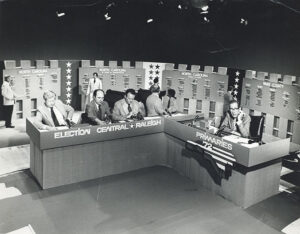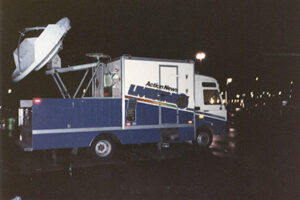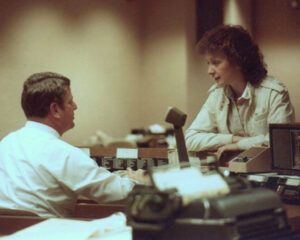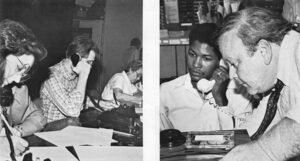
“The more you read and observe this politics thing, you’ve got to admit that each party is worse than the other. The one that’s out always looks the best.” – Will Rogers (1879-1935)
Election night is a test of teamwork and technology. The technology piece has advanced from telephones and studio cameras to “magic boards and walls” showing voting results down to a granular level. It is a time for local stations to strut their electronic stuff and for news anchors and reporters to boil down information to the most basic level, “how does this affect me the viewer.”
 Election coverage in 1972. Charlie Gaddy standing far left.
Election coverage in 1972. Charlie Gaddy standing far left.
In 1972, the television studio was filled with large display boards. Each board was dedicated to coverage of either state or county voting results. Reporters staked out at election headquarters would relay the latest information, by phone, back to the station. Then the numbers on the board would be manually changed to reflect the latest results. If you take a closer look at the picture (left), you will see a young, pre-news anchor Charlie Gaddy on the far left ready to go live with an update.
 Livestar 5 in 1984
Livestar 5 in 1984
A decade later, 1984, there were more news reporters, anchors, producers, and support staff. Engineering offered satellite coverage via KU truck, and other live shots utilized vans with microwave equipment.
Since Raleigh is “ground zero” for state elections, it was not unusual to hear engineers describe the scene of multiple remote vans as “microwave madness.” The Carolina News Network connected four television stations via microwave to four different markets: WSOC in Charlotte, WFMY in Greensboro, WWAY in Wilmington and WRAL in Raleigh.
Satellite coverage could be dicey when trying to book and coordinate satellite time with a forever moving timing target of when a candidate might take the podium to deliver an acceptance or concession speech. It was a source of frustration and headache for producers.
 1984 – Charlie Gaddy, Adele Arakawa and political analyst Dr. Paul Luebke on set. Leesa Moore is the floor director on the left side of picture.
1984 – Charlie Gaddy, Adele Arakawa and political analyst Dr. Paul Luebke on set. Leesa Moore is the floor director on the left side of picture.
Another tongue biter was communication with the satellite or microwave trucks. A producer in the control room would tell the photographer working the remote, “We’ve got video, but no audio.” The reply from the remote would often be, “we’ll, it’s all good on our end.” Meanwhile the news anchor had to either keep ad-libbing or move on to another topic. Thankfully Charlie Gaddy was the grand master of ad lib.
Our primitive, compared to today, computer technology outpaced our competitors. In 1986, CBC’s Corporate Data Processing Department provided a streamlined computer program. Sonny Dowdy, Wes Hassell and Dan Mojar conducted a massive rewrite of CBC’s VAX computer program that was used in finance. The rewrite was able to assimilate information from the League of Women Voters and convert it into results which were integrated into the graphic system for on-air display.
Current WRAL Director of Business Affairs Leah Chauncey recalls there was a back-up-system consisting of several WRAL employees camped out in the conference room who also received the same information from the League of Women Voters. The employees kept a precise ledger sheet of election return data. At one point early in the election coverage, they noted the tallies provided by the VAX were higher than their figures. A quick meeting was held to determine what was going on. The error was discovered and quickly fixed on the computer program.
The election coverage continued and was called “the fastest ever.” WRAL-TV News Director Steve Ramsey said “We were very pleased with our effort. Our people did a super job.”
 Fred Taylor talking with photographer Holly Woodward.
Fred Taylor talking with photographer Holly Woodward.
Of course our secret weapon was Fred Taylor. Kevin Shand, a news producer back in the day, remembers Fred as the ultimate go-to-guy for political insight, reporting, and logistics. Fred was well connected in the arena of North Carolina government movers and shakers. One of the measures of a successful election coverage is to be the first to interview the victor. Fred knew who needed to be “smoothed” to get that hard to get interview, who to talk to about obtaining clearance for setting up live shots, where to house crews working out of town, and of course which police officer to call when a news vehicle landed in the impound lot.
 1986: (Left) Over 100 CBC staffers work the phones in Studio A at WRAL-TV. (Right) WRAL-FM taking an audio feed from the field at the radio studio at the 711 building.
1986: (Left) Over 100 CBC staffers work the phones in Studio A at WRAL-TV. (Right) WRAL-FM taking an audio feed from the field at the radio studio at the 711 building.
Our other platform back then was radio. The North Carolina News Network provided radio listeners across the state with four special election reports an hour, anchored by Mike Edwards. News Director John Wheeling said CBC’s local vote-counting system was the best he had ever worked with. It was also the first time that WRAL-FM used the new Marti transmitter and cell phone system to provide dependable actualities from the field.
Of all the “war stories” told in television stations, it seems that elections provide some of the craziest memories. As a director in the control room back-in-the-day, I have described it as “trying to hang on to a tiger by the tail.” Years later we recall those times with perhaps slight exaggeration, but at least with laughter.
Thanks to Corp’s Pam Allen for this capcom story & photo. Pam Parris Allen is a former WRAL newscast producer/director who now works as a researcher and producer on the CBC History Project.
1984: News Anchor Charlie Gaddy, Reporter/producer Howard Fox, News Producer Celia Hartnett, and Executive News Producer Phyllis Slocum going over election coverage strategy.
1986: (Left) Over 100 CBC staffers work the phones in Studio A at WRAL-TV. (Right) WRAL-FM taking an audio feed from the field at the radio studio at the 711 building.
Fred Taylor talking with photographer Holly Woodward.
1984 – Charlie Gaddy, Adele Arakawa and political analyst Dr. Paul Luebke on set. Leesa Moore is the floor director on the left side of picture.
Livestar 5 in 1984
Election coverage in 1972. Charlie Gaddy standing far left.